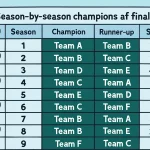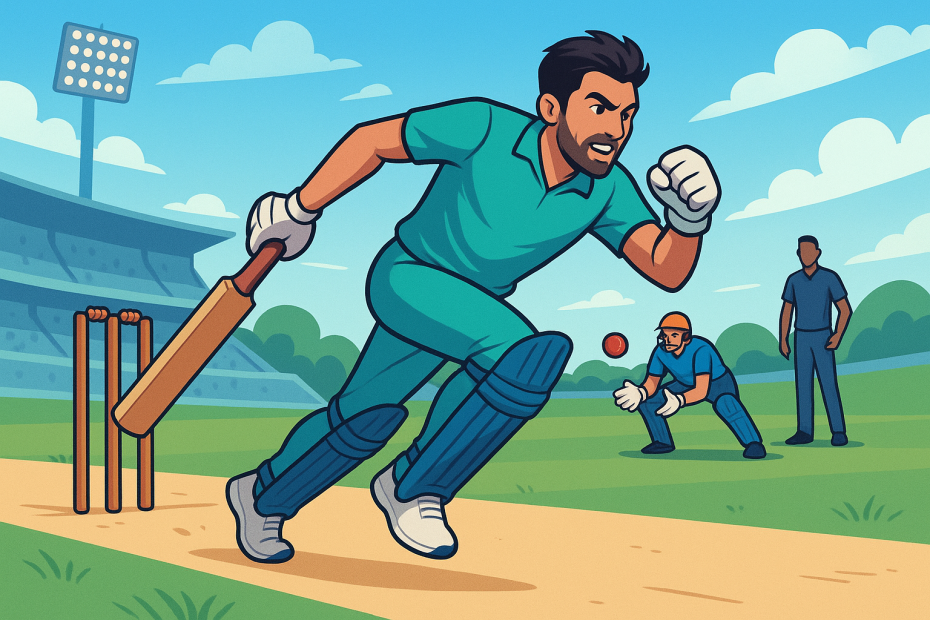Cricket isn’t just a game of bat and ball. Sometimes, the game is won and lost in the mere 22 yards between the wickets. While sixes and lightning deliveries often capture the spotlight, the fierce, unforgiving sprint between wickets—every desperate dive, every hair’s breadth single or blistering double—shapes matches in ways that set the heartbeat of the game racing.
When it comes to speed between the wickets, you’re not just admiring athletic performance; you’re watching a skill forged in the gym, practiced in endless drills, and executed in moments under stadium floodlights with entire nations holding their breath. To understand who truly is the fastest runner in cricket—or why such speed matters—you need to plunge deep into the fabric of modern cricket, the stories behind the sprints, and the names that have turned running between wickets into an art form.
Why Running Speed Matters in Cricket
You’ve seen a batsman take off for a single, the fielding side swooping in, crowd roaring. For those few seconds, nothing matters but pure acceleration, instinct, chaos—and the burning desire to cross 22 yards before the stumps are shattered. Speed between wickets can:
- Convert pressure into runs: Turn dot balls into singles, singles into twos, and disrupt fielding sides.
- Seize crucial moments: Nail a close second run in the final over, scare fielders into mistakes.
- Unleash tactical options: Make it tougher for captains to set fields when every gap threatens to leak twos.
- Tilt momentum: Lightning running shifts morale, exposing tired legs or nerves in the defense.
A team’s best runners—those with raw pace, calculated judgment and telepathic rapport with their partner—can turn the dullest innings into frenetic contests. The fastest batsman between wickets doesn’t just chase personal glory; he changes the very tempo of cricket.
Defining the Fastest Runner in Cricket: Criteria and Considerations
Let’s get one thing clear: Being the fastest runner in cricket isn’t simply about hitting top speed over 22 yards, though that certainly matters. The title blends sprint metrics, decision-making, and the uncanny ability to gauge risk, timing, partner, and fielder with split-second precision.
What Truly Makes the ‘Fastest Cricket Runner’?
- Raw sprinting ability: Quickest acceleration and maximum speed over the pitch.
- Running intelligence: Judgement in calling and partnering for runs.
- Consistency: Repeating sprints through long innings and humid sessions.
- Agility: Ability to pivot, slide, and dive without sacrificing speed.
- Match impact: Using speed to create or save significant runs under pressure.
This is why debates rage on: is MS Dhoni’s legendary bat-swing dive truly faster overall than Virat Kohli’s relentless between-the-wickets engine? Is Ricky Ponting’s sharpness comparable to AB de Villiers’ intensity?
The Science and Technique of Running Between Wickets
At elite level, running between wickets is a brutal examination of biomechanics and cricket intelligence.
Key Techniques That Differentiate the Fastest
- The Drop-and-Drag Start: Legendary sprinters like Dhoni often drop their bat back rather than forward at the crease, reducing turnaround time.
- Minimizing Curve: Taking the shortest line between stumps, avoiding wasted motion.
- Low Center of Gravity: Maintaining balance for a rapid about-turn, often only inches from the ground.
- Communication Cues: Non-verbal glances, hand signals, and pre-run planning to anticipate gaps and fielder arm strengths.
- The ‘Grounding’ Slide: Utilizing a full-length dive or bat-drag, the last desperate act to beat a direct hit.
Bowlers and batsmen frequently rehearse specialized cricket running drills, mimicking match sprints, adjusting stride patterns, and sprinting with heavy bats to simulate match conditions.
Famous Fast Runners: Legends of the Cricket Sprint
Cricket’s history is streaked with stories—of batsmen so fast they could steal singles off fielders almost at will, dare doubles that shouldn’t exist, and create partnerships that left bowlers cursing in frustration.
Let’s spotlight the giants:
MS Dhoni: A Masterclass in Speed
No discussion about the fastest runner in cricket can skip MS Dhoni. The “Unstoppable Finisher” wasn’t just supreme behind the stumps; his staggering between-wicket pace has achieved near-mythical status.
Dhoni’s Greatest Weapon:
- Bat-drag Dive: His iconic drag, bat outstretched, head low, blurred in photo-finish replays and has decided too many matches to count.
- Acceleration: Racing off the blocks, even late in long chases when most batsmen are exhausted.
- Judgement: Calculated aggression, knowing exactly when to snatch a risky run.
In a legendary T20 international, Dhoni completed a two between the wickets quicker than most cricketers could dash for a single. It’s been measured—he’s clocked timed sprints for two runs in under 7 seconds from crease to crease, which is jaw-dropping in pressure situations.
A Snapshot
| Run | Distance (meters) | Dhoni’s time (sec) |
|---|---|---|
| Single | 22 | 2.7 – 2.9 |
| Double | 44 | 6.6 – 7.1 |
(Dhoni’s peak times as observed by national coaching staff and broadcast analysis.)
Virat Kohli: Relentless Fitness and Precision
Intensity, energy, and absolute fitness have always hallmarked Virat Kohli’s game. While less flamboyant in the slide than Dhoni, Kohli has set new standards for running speed in cricket’s modern era.
What Sets Kohli Apart:
- Unrelenting fitness: Sprints repeated with almost no fatigue, even late into brutal innings.
- Partnerships: Champions, orchestrating sharp singles, exploiting fielders’ weak arms, creating runs that didn’t exist.
- Agility in Turning: Lightning turnarounds at the crease, making even sharp twos look routine.
In a remarkable ODI, Kohli was clocked completing three runs in approximately 10.4 seconds—averaging just about 3.5 seconds per run, at the tail end of a marathon stint at the crease.
Other Lightning-Speed Batsmen
The pantheon of fastest runners in cricket history covers diverse eras and styles. Some other revered sprinters include:
- AB de Villiers: His lateral explosiveness and 360-degree awareness made him a perpetual threat for turning singles into doubles.
- Ricky Ponting: Set the standard for running intensity; built Australia’s run machines on electric sprints and sharp calls.
- Jonty Rhodes: More famous for his fielding, but his relentless running between the wickets in one-dayers remains a template.
- David Warner: Quick off the mark and eager to challenge fielders, Warner built an aggressive running style fitted for T20 and ODIs.
- Kane Williamson: Understated but extremely efficient, making sharp judgement calls, rarely running a risky single.
Top 10 Fastest Runners in Cricket: In-Depth Analysis
Who tops the charts for fastest cricketers between the wickets? Here is a list that merges raw times, match evidence, and professional insights.
| Position | Player | Key Formats | Remarkable Speed Traits | Highlight Moment |
|---|---|---|---|---|
| 1 | MS Dhoni | ODI, T20I | Dive, acceleration, late innings burst | Lightning double in Ind-Aus |
| 2 | Virat Kohli | ODI, T20I | Relentless fitness, sharp twos/three runs | Blistering 3 in tight chase |
| 3 | AB de Villiers | ODI, T20I | Athletic turn, risk calculation | Impossible double, WC clash |
| 4 | Ricky Ponting | ODI, Test | Early singles, aggressive intent | Turning singles/doubles, 100s |
| 5 | David Warner | T20I, ODI | Early sprints, pressure running | Streak of quick singles |
| 6 | Jonty Rhodes | ODI | Lightning from ball contact | Turned dots into doubles |
| 7 | Kane Williamson | Test, ODI | Clinical, never tiring, sharp judgement | Efficient 80+-run stands |
| 8 | Mohammad Kaif | ODI, Test | Dives and relentless energy | Famous NatWest Final chase |
| 9 | Mohammad Azharuddin | ODI, Test | Late bursts, sharp 2s with tailenders | Classic late partnerships |
| 10 | Ben Stokes | Test, ODI | Willpower in high-stakes sprints | Miracle runs at Headlingley |
Note: Metric references are based on match data, commentary consensus, and coaching insights. Times are best-attributed estimates due to broadcast and coaching records.
Speed Records and Statistics: Breaking Down the Numbers
Cricket’s running speed isn’t as cleanly measured as track athletics, but modern technology, broadcast analytics, and high-performance teams have begun logging detailed split-second timings for things such as:
- Fastest two between wickets in cricket: National teams use GPS and laser timing. Dhoni, Kohli, and De Villiers frequently clock sub-7 second doubles.
- Fastest single run in cricket: High 2.7 seconds crease to crease in peak cases—Kohli and Warner are often cited for breaking this barrier.
- Fastest triple (3 runs) between wickets: Several matches note 3-run sprints under 11 seconds in ODIs and T20s.
- Speed Record Cricket Run: Not official world records, but top-level fitness datasets frequently cite Dhoni, Kohli, and AB for holding these virtual titles.
Cricket Running Records by Format
| Format | Typical Fastest Single (sec) | Notable Sprinters |
|---|---|---|
| ODI | 2.7 – 3.0 | Dhoni, Kohli, Ponting |
| T20I | 2.7 – 2.9 | Warner, De Villiers |
| Test | 2.8 – 3.1 | Williamson, Stokes |
Real match distances may vary by crease widths, dive vs. stride, and pressure moments.
Match Moments: Game-Changing Runs Between Wickets
If you think running between the wickets is a secondary skill, remember the following fierce moments—when sheer speed and agility stole matches from defeat.
Key Highlights
- Dhoni’s Final Over Lightning Double: In a tense white-ball match, Dhoni turned a certain single into a quick second, beating a direct-hit with the infamous bat-drag. India scraped through by a solitary run.
- Kohli’s Three in the Death: During a crucial chase, he set off for three runs on the second-last ball of the inning, lapping a tired field—most batsmen would have settled for two.
- Ponting-Michael Bevan Partnership: Australia’s relentless grinding under pressure, with singles and doubles snatched at will, demoralizing opposition spinners by refusing dot deliveries.
- De Villiers’ Impossible Double: Flicking the ball past midwicket, De Villiers turned and completed the fastest two between wickets seen in the South African domestic circuit, barely sliding in before a bullet throw.
- Kaif-Yuvraj’s Miracle Run: The NatWest series finale saw India’s youthful pair take risky doubles against bullet fielders, running England ragged in a pressure cooker.
These aren’t just fun highlights—they’re moments on which careers and legacies have turned.
Training and Developing Speed: Tips From Elite Cricketers
Running between wickets at top speed can be lonely, exhausting, and high-risk. Yet it’s a skill that can be trained, sharpened, and weaponized, as many international cricketers prove.
Cricket Running Drills
1. Shuttle Sprints:
Batsmen sprint 22 yards repeatedly, focusing on sharp turns at the crease. Coaches emphasize acceleration out of the blocks and diving slides to finish.
2. Partner Simulation Runs:
Pairs simulate calling and responding, working on both communication and synergy.
3. Bat Weighting:
Players train with weighted bats to build muscle memory, making normal running feel easier during games.
4. Reaction Sprints:
Start runs on random stimuli—whistle, clapper, or coach’s shout—to mimic surprise singles and sudden calls.
Cricket Fitness Exercises for Speed
- Plyometric Box Jumps: Upping explosive leg power, improving ability to sprint and turn.
- Interval Track Sprints: Short, brutal speedwork to build burst speed for doubles and threes.
- Agility Ladder Workouts: Mimic field footwork, helping with rapid direction changes.
- Core Stability Training: Enhances low center of gravity and balance when pivoting or diving.
Fitness standards, led by thorough scientific regimens (think of Kohli’s fitness revolution), have rocketed running standards across all formats.
Running Tactics: Cricket Formats and Speed
Not all matches demand or reward the same running approach.
Test Cricket
- Endurance Over Explosiveness: Batting for hours, saving runs for later, and exploiting tiring fielders in long spells.
- Risk Management: Fewer risky singles owing to field proximity; maximizing twos in open spaces.
ODI Cricket
- Speed in Middle Overs: Turning 1s into 2s is key, forcing bowlers off their rhythm. Partnerships that run well (Kohli-Rohit, Ponting-Waugh) drive totals towards hefty numbers.
- Strategic Pressure: Taking a risky single to expose weak fielders or exploit moments after quick field changes.
T20 Cricket
- All-Out Aggression: Even with boundary-hitting, sharp singles and doubles are gold. Fastest batsman between wickets can tilt the game in low-scoring contests.
Comparisons: Dhoni vs. Kohli and Other Fascinating Rivalries
Cricket fans and analysts endlessly debate: who is the fastest cricket runner? Two names dominate: MS Dhoni and Virat Kohli.
Who is Faster—Dhoni or Kohli?
| Parameter | MS Dhoni | Virat Kohli |
|---|---|---|
| Peak Acceleration | Explosive, late innings | Relentless, early-mid |
| Endurance | High, famous for finish | Elite, rarely tires |
| Dive Execution | Low, bat-drag specialty | Occasional, prioritizes turn |
| Partnership Calls | Often leads, intuitive | Vocal, quick responder |
| Fastest 2 (unofficial stat) | ~6.7 sec (noted in T20I) | ~6.8 sec (measured in ODI) |
Expert View: Dhoni’s bat-drag and late-innings speed are legendary; Kohli’s consistency and ability to repeat sprints through the innings are unmatched.
Who Else? (FAQs)
- Who has the fastest 3 between wickets in cricket?
Sources credit Kohli and Warner for sub-11 second three runs in recent ODIs. - Who is the fastest fielder in cricket?
Jonty Rhodes, AB de Villiers, and Ravindra Jadeja are often named for raw speed and reflexes in the field.
Frequently Asked Questions: Cricket Running Speed
Who is the fastest runner in cricket history?
Accolades usually contest between MS Dhoni and Virat Kohli, with AB de Villiers and Ricky Ponting just behind. No universally-accepted time-based “world record” due to variable match circumstances.
What is the world record for running between wickets in cricket?
While not officially recognized by ICC, timings below 2.8 seconds for a single and around 6.7 seconds for a double have been cited for elite players.
What makes a good partnership between fast runners?
Trust, communication, and shared risk appetite. Iconic pairs (e.g., Kohli-Rohit, Ponting-Bevan) steal runs beyond their own speed via synergy.
How do I improve running speed in cricket?
Practice specific cricket running drills, emphasizing quick acceleration, sharp turns, reaction to calls, and diving prowess under pressure.
Are there running tips for cricket beginners?
Start by always watching the ball, communicate with your partner, and take the first run quickly—never hesitate once committed.
Final Thoughts: The Unseen Impact of Cricket’s Fastest Runners
Cricket’s greatest stories aren’t just built on towering sixes or venomous bouncers. They’re built, often, on the silent art of sprinting between the wickets—those split seconds of madness and genius, where a single run can win the day and create legends.
The fastest runner in cricket is more than an athlete—they’re a tactician, a leader, and a showman operating in that flash of chaos between bat and ball. From Dhoni’s outstretched bat-drag, to Kohli’s never-say-stop engine, to the unsung speedy partnerships that set up dramatic finishes, speed between wickets remains one of the purest joys of the game—stealthy, electrifying, and, for those bold enough to try, the difference between immortality and heartbreak.
So the next time you watch a one-day epic or a late-innings T20 chase, keep your eyes not just on the boundaries but the feet, the heartbeat, and the split-second decisions of the fastest runners in cricket. For in those furious dashes, cricket’s very soul is revealed.
Key Takeaways
- Speed between wickets is a decisive, game-changing skill in cricket.
- MS Dhoni, Virat Kohli, and AB de Villiers top most rankings for fastest batsman between wickets.
- Cricket running records and running drills form a crucial part of modern cricket training.
- Sprinting prowess in cricket isn’t just about raw speed—timing, judgement, and trust are just as vital.
- Fast runners are often the silent architects behind winning moments.
Further Reading
Related posts:
Cricket Prince: Who's the Heir — Lara, Gill, or Babar?
T20 Highest Score Guide: Team Totals, Records & Context
Youngest cricketer in India: Complete Guide to Records & Pathways
Psl winners list: Season‑by‑season champions & finals
About vignesh puthur - Official bio, work & contact
How Many Countries Play Cricket? 108 ICC Members (Updated Oct)
Angad Mehra

- Angad Mehra is an avid cricket analyst and sports writer who pays attention to betting patterns and match specifics. Angad has years of experience writing, covering both Indian and international cricket. He explains stats, odds, and strategies in a clear, simple manner that resonates with fans. Readers trust Angad’s articles to keep them ahead of the game whether on or off the field. Off the field, you can find him either tracking live scores ball by ball or debating IPL lineup changes.
Latest entries
 GeneralNovember 1, 2025Cricket Prince: Who’s the Heir — Lara, Gill, or Babar?
GeneralNovember 1, 2025Cricket Prince: Who’s the Heir — Lara, Gill, or Babar? GeneralOctober 31, 2025T20 Highest Score Guide: Team Totals, Records & Context
GeneralOctober 31, 2025T20 Highest Score Guide: Team Totals, Records & Context GeneralOctober 29, 2025Youngest cricketer in India: Complete Guide to Records & Pathways
GeneralOctober 29, 2025Youngest cricketer in India: Complete Guide to Records & Pathways GeneralOctober 27, 2025Psl winners list: Season‑by‑season champions & finals
GeneralOctober 27, 2025Psl winners list: Season‑by‑season champions & finals
